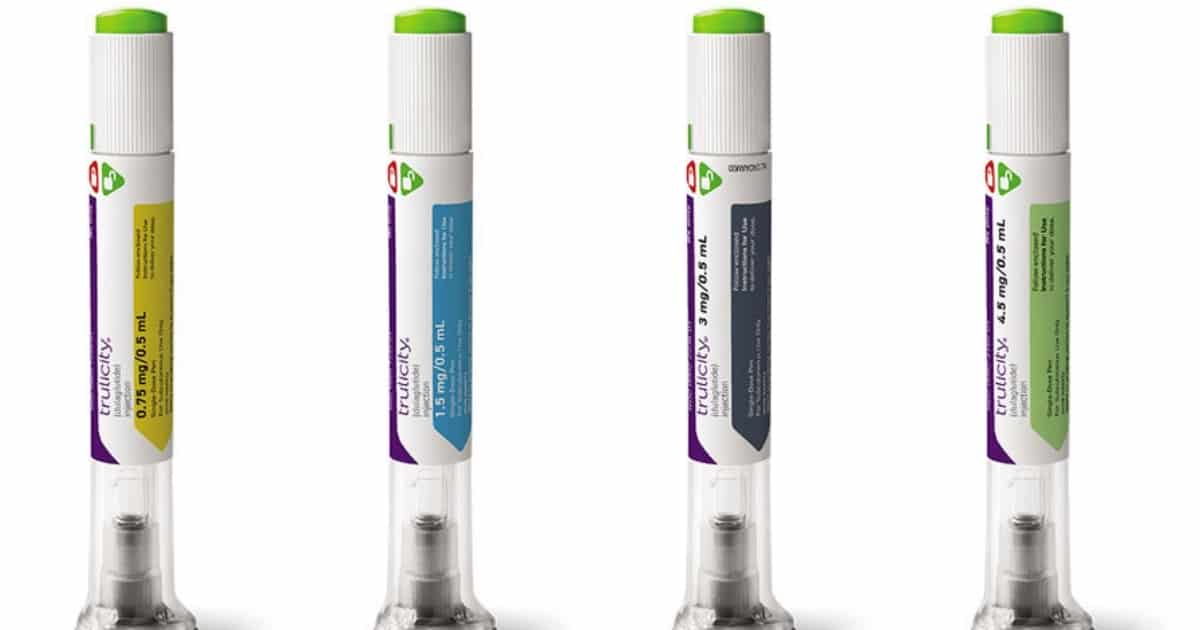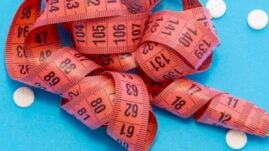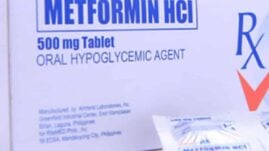When starting any new diabetes medication, it is important to know the pros and cons of the therapy.
This includes any side effects and reactions you may experience and what you can and can’t eat while taking the medication.
This article will explore the foods that you should avoid when starting Trulicity, and everything you need to know about this diabetes drug.

What is Trulicity?
Trulicity is the brand name for the drug Dulaglutide, which is a once-weekly injection taken for the treatment of type 2 diabetes (and sometimes in off-label use for people with type 1 diabetes who are struggling with insulin resistance).
In combination with diet and exercise, it helps people better manage high blood sugar levels and may improve HbA1c by between 0.8-1.6%!
It is also approved in the United States for adults with type 2 diabetes and established cardiovascular (heart) disease to reduce the risk of heart attack. It also lowers all-cause mortality in people with diabetes.
While not approved by the Food and Drug Administration (FDA) for weight loss, that is a common side effect in people who take Trulicity, who typically lose between 2-7 lbs while taking the drug.
Trulicity is not insulin. It is a glucagon-like peptide-1 receptor agonist, or a GLP-1 agonist, and was first approved for use in the United States in 2014. It can be taken in conjunction with insulin.
There are more than 5 million prescriptions written yearly for the drug.
How does Trulicity work?
Trulicity lowers blood sugars by attaching itself to certain receptors on the cells of the pancreas, telling your pancreas to release more insulin than it currently is (if you have prediabetes or type 2 diabetes). This lowers blood sugar naturally.
Trulicity also slows down digestion, helping to prevent your blood sugars from spiking after you eat. Trulicity also blocks the release of glucagon from the liver, thus lowering blood sugars even more and increasing insulin sensitivity.
By lowering your blood sugars over the long term, Trulicity also reduces one’s risk of heart disease and heart attack.
Foods to avoid when taking Trulicity
While Trulicity has not been contraindicated with any food in particular, there are some helpful guidelines to make your experience taking Trulicity more enjoyable.
Trulicity can be taken with or without food, so if you’re prone to nausea, you might want to take Trulicity on an emptier stomach.
It is recommended to eat smaller meals more often, instead of larger meals spread out over the course of a day. It is recommended that you eat slowly, to help prevent nausea. And stick with light and bland foods (especially when first starting Trulicity).
Since Trulicity can slow digestion, it’s best to avoid fried or fatty foods and food high in sugar when taking the medicine. These types of food are some of the hardest for the body to digest and may increase nausea while taking a GLP-1.
When first starting Trulicity, stick with clear liquids for drinks, and avoid dairy and full-fat drinks (like milkshakes). This may decrease the likelihood of vomiting and nausea.
You may want to be more mindful of your alcohol consumption while taking Trulicity, especially if you’re also on insulin.
Both alcohol and Trulicity both cause hypoglycemia (low blood sugar), and your risk of experiencing a low blood sugar increases significantly, especially when first starting Trulicity. It’s helpful to figure out how your body responds to Trulicity first, before consuming alcohol.
If you become nauseous after eating with Trulicity, switch your next meal to toast, a banana, or rice and applesauce, and call your doctor.
Your doctor may be able to modify and lower your Trulicity dose until your body has time to adjust.
What foods should I eat on Trulicity?
Since Trulicity is used to help improve blood sugar and HbA1c levels, it’s best to eat a healthy diet full of lean protein, healthy fiber, and plenty of antioxidants, vitamins, and minerals, to support your health as a person with diabetes.
If you’re taking Trulicity to improve insulin sensitivity or lose weight, you should include the following foods as well:
- Plenty of vegetables, including leafy greens and root vegetables
- Fruits, especially low-carbohydrate vegetables like berries, avocado, and coconut
- Legumes and all types of beans
- Lean proteins like chicken, beef, turkey fish, and low-fat dairy (milk and yogurt)
- Eggs
- Unsweetened drinks like coffee, tea, and plenty of water (especially to avoid dehydration if you experience diarrhea or vomiting while taking the medication)
Remember, start slowly, and begin with more bland foods like toast, crackers, soup, rice, or bananas if you are experiencing uncomfortable side effects as a result of Trulicity.
Work with your doctor to create a healthy meal plan that will work for you, or work with a registered dietitian or nutritionist to create a meal plan that will help you meet your goals.
What are the side effects of Trulicity?
People who take Trulicity may experience several uncomfortable side effects, especially when first starting to take the drug. These side effects include:
- Decreased appetite
- Nausea
- Indigestion
- Vomiting
- Abdominal pain
- Injection site reactions, like bruising, redness, swelling, or pain
- Fatigue
- Diarrhea
- Weight loss
- Low blood sugar (when used in conjunction with insulin)
A few serious side effects have been noted, including acute pancreatitis, severe allergic reactions, renal impairment, and (although rarely), medullary thyroid carcinoma (MTC).
If you have a family history of MTC or multiple endocrine neoplasia you should not take Trulicity.
The FDA released a black box warning to the public about taking Trulicity and its ability to increase your risk for thyroid cancer.
Talk with your doctor before trying Trulicity if you suffer from gastroparesis, have existing retinopathy, or have chronic kidney disease (CKD).
Summary
Trulicity, also known as dulaglutide, is a relatively new diabetes drug that was first approved by the FDA for use in the United States in 2014.
It is a GLP-1 receptor antagonist medication (that comes in a once-weekly injection) used for people with type 2 diabetes to help them manage their blood sugars better.
It can also be used by people with type 1 diabetes who are struggling with insulin resistance and for those with diabetes looking to lose weight.
It is not insulin and can be used in conjunction with insulin, although that increases the risk of hypoglycemia.
Trulicity’s common side effects include nausea, vomiting, decreased appetite, weight loss, diarrhea, indigestion, abdominal pain, and fatigue. In rare cases, people may experience acute pancreatitis, renal impairment, or a severe allergic reaction.
The drug increases your risk for thyroid cancer and you should not use Trulicity if you have a family history of medullary thyroid carcinoma (MTC).
Trulicity can be taken with or without food. When taking Trulicity, you should be mindful of your alcohol consumption, avoid fried and fatty foods, avoid large meals, and start slowly.
If you experience nausea and/or vomiting when eating your regular diet, contact your doctor about changing up your meal plan or modifying/lowering your Trulicity dose.



